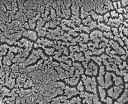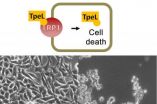(Press-News.org) SAN ANTONIO, Texas (April 16, 2014) — A team that includes scientists from the School of Medicine at The University of Texas Health Science Center at San Antonio, Johns Hopkins University and St. Mary's University reported the structure of a protein that helps a common fungus to infect the body.
The fungal pathogen Candida albicans causes yeast infections, diaper rashes and oral thrush, and is the most common fungal pathogen to infect humans. It can also cause a life-threatening infection of the blood called disseminated candidiasis.
"In this study, we determined the three-dimensional structure of a never-before-seen cell wall protein called SOD5 that the organism uses as a defense against the human immune system," said P. John Hart, Ph.D., the Ewing Halsell-President's Council Distinguished Professor of biochemistry at the UT Health Science Center and Research Scientist in the South Texas Veterans Health Care System.
"SOD5 is a copper-only protein that exhibits significant structural differences from copper/zinc superoxide dismutases (SODs)," Dr. Hart said. "Because SOD5 molecules are widespread throughout fungi, including C. albicans, but are not found in humans, the structural differences can be exploited to develop compounds that specifically target SOD5 to treat a number of widespread fungal infections."
Current conventional antifungal treatments such as fluconazole can be toxic to the liver in certain individuals, he noted.
"SOD5 is an unprecedented, very powerful antioxidant protein that enables C. albicans to ward off free radicals of the host immune response," said study senior author Valeria Culotta, Ph.D., professor of biochemistry and molecular biology and environmental health sciences at the Johns Hopkins University Bloomberg School of Public Health. Free radicals are highly reactive molecules that can cause oxidative damage.
INFORMATION:
The finding was published April 7 online ahead of print by the journal Proceedings of the National Academy of Sciences of the United States of America.
Study collaborators included Drs. Hart and Culotta; Julie Gleason, Ph.D., and Ryan Peterson, Ph.D., also of the Bloomberg School of Public Health; Ahmad Galaleldeen, Ph.D., and Jessica Waninger-Saroni, B.S., of St. Mary's University in San Antonio; Alexander Taylor, Ph.D., and Stephen Holloway, Ph.D., of the Department of Biochemistry at the UT Health Science Center at San Antonio; Brendan Cormack, Ph.D., of the Johns Hopkins University School of Medicine; and Diane Cabelli, Ph.D., of Brookhaven National Laboratories in Upton, N.Y.
For current news from the UT Health Science Center San Antonio, please visit our news release website, like us on Facebook or follow us on Twitter.
About The University of Texas Health Science Center at San Antonio
The University of Texas Health Science Center at San Antonio, one of the country's leading health sciences universities, ranks in the top 3 percent of all institutions worldwide receiving National Institutes of Health funding. The university's schools of medicine, nursing, dentistry, health professions and graduate biomedical sciences have produced more than 29,000 graduates. The $765 million operating budget supports eight campuses in San Antonio, Laredo, Harlingen and Edinburg. For more information on the many ways "We make lives better®," visit http://www.uthscsa.edu.
Scientists unlock secrets of protein produced by disease-causing fungus
2014-04-16
ELSE PRESS RELEASES FROM THIS DATE:
Vanderbilt researchers discover how intestinal cells build nutrient-absorbing surface
2014-04-16
The "brush border" – a densely packed array of finger-like projections called microvilli – covers the surfaces of the cells that line our intestines.
Vanderbilt University researchers have now discovered how intestinal cells build this specialized structure, which is critical for absorbing nutrients and defending against pathogens. The findings, published April 10 in the journal Cell, reveal a role for adhesion molecules in brush border assembly and increase our understanding of intestinal pathologies associated with inherited and infectious diseases.
Pathogens that destroy ...
Surveillance colonoscopy recommendations for average-risk patients with 1 to 2 small polyps consistent with guidelines
2014-04-16
DOWNERS GROVE, Ill. – April 16, 2014 – According to a new study, endoscopists' recommendations for timing of surveillance colonoscopy in average-risk patients with one to two small polyps are consistent with guideline recommendations in about 90 percent of cases. This may be an appropriate target for quality indicators. This is the first multicenter endoscopic database study to quantify adherence to guidelines for timing of repeat colonoscopy after one to two small polyps are found during screening colonoscopy in average-risk patients. The study appears in the April issue ...
Scientists capture ultrafast snapshots of light-driven superconductivity
2014-04-16
A new study pins down a major factor behind the appearance of superconductivity—the ability to conduct electricity with 100 percent efficiency—in a promising copper-oxide material.
Scientists used carefully timed pairs of laser pulses at SLAC National Accelerator Laboratory's Linac Coherent Light Source (LCLS) to trigger superconductivity in the material and immediately take x-ray snapshots of its atomic and electronic structure as superconductivity emerged.
They discovered that so-called "charge stripes" of increased electrical charge melted away as superconductivity ...
Eavesdropping on brain cell chatter
2014-04-16
Everything we do — all of our movements, thoughts and feelings – are the result of neurons talking with one another, and recent studies have suggested that some of the conversations might not be all that private. Brain cells known as astrocytes may be listening in on, or even participating in, some of those discussions. But a new mouse study suggests that astrocytes might only be tuning in part of the time — specifically, when the neurons get really excited about something. This research, published in Neuron, was supported by the National Institute of Neurological Disorders ...
How kids' brain structures grow as memory develops
2014-04-16
Our ability to store memories improves during childhood, associated with structural changes in the hippocampus and its connections with prefrontal and parietal cortices. New research from UC Davis is exploring how these brain regions develop at this crucial time. Eventually, that could give insights into disorders that typically emerge in the transition into and during adolescence and affect memory, such as schizophrenia and depression.
Located deep in the middle of the brain, the hippocampus plays a key role in forming memories. It looks something like two curving fingers ...
Theoretical biophysics: Adventurous bacteria
2014-04-16
To reproduce or to conquer the world? Surprisingly, bacteria also face this problem. Theoretical biophysicists at Ludwig-Maximilians-Universitaet (LMU) in Munich have now shown how these organisms should decide how best to preserve their species.
The bacterium Bacillus subtilis is quite adaptable. It moves about in liquids and on agar surfaces by means of flagella. Alternatively, it can stick to an underlying substrate. Actually, the bacteria proliferate most effectively in this stationary state, while motile bacteria reproduce at a notably lower rate.
In order to sustain ...
Significant baseline levels of arsenic found in Ohio soils are due to natural processes
2014-04-16
RICHLAND, Wash. – Geologic and soil processes are to blame for significant baseline levels of arsenic in soil throughout Ohio, according to a study published recently in the Journal of Environmental Quality.
The analysis of 842 soil samples from all corners of Ohio showed that every single sample had concentrations higher than the screening level of concern recommended by the U.S. Environmental Protection Agency. The findings should not alarm the public, say the authors, who note that regulatory levels typically are set far below those thought to be harmful. Rather, the ...
Preterm births, multiples, and fertility treatment
2014-04-16
While it is well known that fertility treatments are the leading cause of increases in multiple gestations and that multiples are at elevated risk of premature birth, these results are not inevitable, concludes an article in Fertility and Sterility. The article identifies six changes in policy and practice that can reduce the odds of multiple births and prematurity, including expanding insurance coverage for in vitro fertilization (IVF) and improving doctor-patient communications about the risks associated with twins.
Financial pressures provide a powerful incentive for ...
Gate for bacterial toxins found
2014-04-16
Prof. Dr. Dr. Klaus Aktories and Dr. Panagiotis Papatheodorou from the Institute of Experimental and Clinical Pharmacology and Toxicology of the University of Freiburg have discovered the receptor responsible for smuggling the toxin of the bacterium Clostridium perfringens into the cell. The TpeL toxin, which is formed by C. perfringens, a pathogen that causes gas gangrene and food poisoning. It is very similar to the toxins of many other hospital germs of the genus Clostridium. The toxins bind to surface molecules and creep into the body cell, where they lead to cell death. ...
Scientists explain how memories stick together
2014-04-16
LA JOLLA—Scientists at the Salk Institute have created a new model of memory that explains how neurons retain select memories a few hours after an event.
This new framework provides a more complete picture of how memory works, which can inform research into disorders liked Parkinson's, Alzheimer's, post-traumatic stress and learning disabilities.
"Previous models of memory were based on fast activity patterns," says Terry Sejnowski, holder of Salk's Francis Crick Chair and a Howard Hughes Medical Institute Investigator. "Our new model of memory makes it possible to ...






